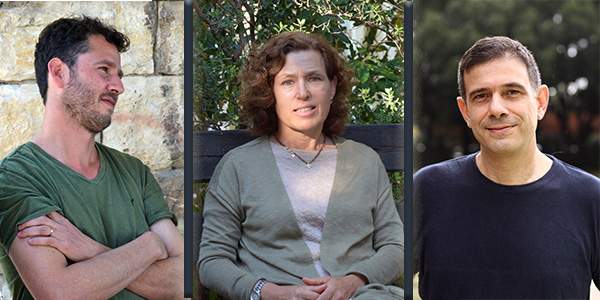Are you a journalist? Please sign up here for our press releases
Subscribe to our monthly newsletter:

“A kind of evolution is taking place in our bodies all the time,” says Prof. Yoav Soen of the Biomolecular Sciences Department at the Weizmann Institute of Science. “Every cell, just like every plant and animal, has to overcome an onslaught of internal malfunctions that are unique to each individual. Natural selection cannot adequately explain how this type of adaptation comes about, because selection does not change the individuals; it selects them based on existing genetic mutations. This selection may apply well to adaptation of a population as a whole, but less so to the ongoing adaptations within every individual.” To explain how individual adaptation may come about, Soen and his group members, Dr. Michael Elgart and Maor Knafo, proposed a concept they call “adaptive improvisation” – a semirandom way of keeping things in balance even as changes occur.
Their theory of adaptive improvisation takes into account adaptations that are not necessarily written in the genome – or anywhere else, for that matter. They can be acquired, for example, by newly forming changes in the individual’s microbiota, as well as by nongenetic modifications in gene regulation. Many of these changes are unpredictable, but they are generally not lethal. This bias toward nonlethal variation is a long-term evolutionary outcome of natural selection, which retains only those organisms with regulatory mechanisms that selectively prevent large changes in critical traits. Soen explains that adaptive improvisation is an organization principle that enables the individual to reach a new balance – homeostasis – under new conditions.
Theoretical evaluation of this idea requires a modeling framework allowing a rigorous examination of the ways in which an individual organism or cell might overcome new problems simply by exploration. If an organism has to randomly explore an astronomical number of potential changes, how does it arrive at one that is adaptive? This question was addressed in collaboration with Prof. Naama Brenner and Hallel Schreier, a member of Brenner’s group at the Technion. In work that was recently published in Nature Communications, they introduced a new mathematical framework that provides substantial support for the improvisation concept.
The model – of exploration in a high-dimensional network – represents a single individual (for example, a single cell) that is subjected to a new challenge. This model is similar to that of neural networks in the brain, but it is devoid of a “learning” algorithm to recommend subsequent directions of change. In the absence of recommended directions, the cell must arrive at a solution by purely random exploration of its possibilities. To simulate this process, the scientists subjected the model cell to an arbitrary demand that is not met by the initial design of the cell. Could random changes in this cell (for example in the ways that genes are employed) lead to a new, altered function that meets the demand?

Simulations of this new model indeed demonstrated the feasibility of adaptation by random improvisation within “individuals” and uncovered key underlying requirements for this process. In particular, the simulations revealed that adaptation depends on having a small number of hubs – network nodes that are capable of influencing a great number of other nodes within the network. Furthermore, when these hubs were able to regulate themselves, the adaption capacity was enhanced. Soen points out that intracellular gene regulatory networks do seem to be built to function in this way: Transcription factors that bind to many regulatory regions in the genome, often in response various signals, are an excellent example of this. The model may thus provide a framework for a new understanding of adaptive processes in cells.
Although the simulations described in this research are taken to represent adaptation in single cells, the model is equally applicable to the lifelong process of adaptation in whole plants, animals and other types of complex organization. In humans, for example, stress-induced changes may affect the individual’s microbiome. These changes in the bacterial population affect the state of the individual host. These changes can sometimes be unpleasant but are usually nonlethal. Eventually, both the human host and the bacteria converge to a new state of homeostasis.
Darwinian selection and Lamarckian adaptation by improvisation turn out to be fully compatible
Soen notes that some of these newly acquired changes – those in the gut microbiome, for instance – can be passed on to the next generation. This fits with the theories of Jean-Baptiste Lamarck, who suggested that individuals can adapt to changing environments and pass these adaptations to their offspring. For many years, this view of Lamarck was considered unfeasible and was replaced by the concept of Darwinian selection of existing mutations, but researchers have, in recent years, begun to reconsider the Lamarckian possibility of inheriting environmentally induced traits. “Darwinian selection and Lamarckian adaptation by improvisation turn out to be fully compatible,” says Soen. “Populations adapt through natural selection, while individuals adapt by natural improvisation. The extent of improvisation is determined by the type and strength of the stress, with no need for ‘computation’ or ‘decision making.’”
“The concepts of natural selection and adaptive improvisation may be further unified by viewing a single species as a multigenerational, ‘metaindividual.’ The genetic content of this metaindividual changes over time by selection of mutations that emerge in individuals. Changes that reduce the strength of selection may by preferentially spread in the population, increasing the adaptation of the species as a whole. Put differently, the process of genetic adaptation is governed by changes that alleviate ‘genetic stress.’ The ongoing selection of emerging mutations can thus be viewed as a specific example of adaptation by improvisation, which operates across time at the species level. Adaptive improvisation may therefore constitute a unified principle of adaptation that covers all levels and timescales of organization.”
Prof. Yoav Soen's research is supported by the Benoziyo Fund for the Advancement of Science; theDr. Pearl H. Levine Foundation for Research in the Neurosciences; the Leona M. and Harry B. Helmsley Charitable Trust; and Dr. Karen Mashkin, Boca Raton, FL.